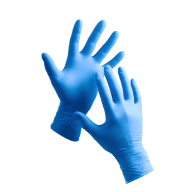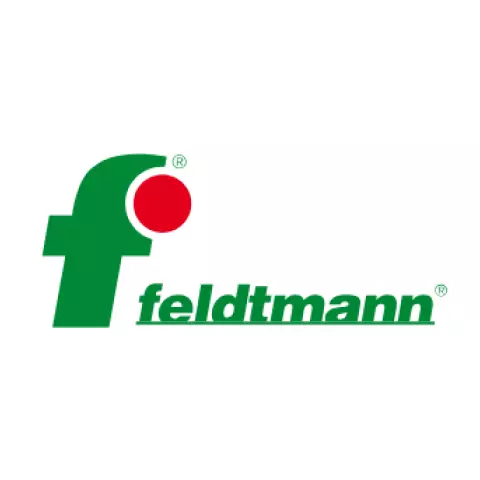SEMPERMED SEMPERGUARD® NITRILE XTRA LITE Disposable Gloves
Feldtmann
visit storeProduct description
Norm: En 455, En 374/2+3, Kat.3 Material: Nitrile, Powderfree, Blue thickness: 0,12 mm (Double Measured) Length: 24 Cm Sizes: 6 7 (S),7 8 (M),8 9 (L), 9 10 (Xl) Aql: 1,5· Light Nitrile Glove With Great Flexibility· Certified For Food Contact
Indicates the composition of the gloves, affecting properties like elasticity, chemical resistance, allergen potential, and suitability for specific tasks.
Indicates the glove's pigmentation, which can aid in color-coding tasks, enhancing visibility, or meeting specific industry requirements for contamination control.
Refers to whether gloves have a smooth or textured finish, affecting grip strength, dexterity, and handling ability in wet or dry conditions.
Indicates whether gloves contain donning powder. Powder-free options reduce allergen risks and contamination, while powdered versions offer easier application.
Crafted without natural rubber latex, these gloves are ideal for sensitive skin. Provides a comfortable fit for those with latex sensitivities.
Offers complete hand coverage, ensuring hygiene and protection. Ideal for various tasks requiring a barrier against contamination and maintaining cleanliness.
Offers versatile hand protection for various tasks. Balances durability and flexibility, suitable for diverse applications requiring barrier protection.
Describes whether fingertips have a smooth or textured surface, affecting grip strength, tactile sensitivity, and handling precision for various applications.
Indicates the statistical quality inspection standard measuring defect rates. Lower AQL values (e.g., 0.65) signify fewer defects and higher protection reliability.
Measures from fingertip to cuff end, determining wrist/forearm coverage. Longer gloves provide enhanced protection against splashes and contaminants.
- Slip Resistant
- Medical Protection
- Antimicrobial Protection
- Hand Protection
- Chemical Resistance
Request a free sample
Test first and buy later. Visit any product page to request your free sample.
Standards and labels
EN 455-1:2020 is a European standard for disposable medical gloves. It sets out the definition, performance requirements and test methods for this type of gloves. The standard includes requirements for freedom from holes, tensile strength, elongation, packaging, freedom from powder, freedom from protein, freedom from endotoxins, and freedom from pyrogens. Test results can include measurements of the gloves' freedom from holes, tensile strength, elongation, packaging, freedom from powder, freedom from protein, freedom from endotoxins and freedom from pyrogens. This version of the standard includes some changes and updates from the 2000 version.
Test results
Tightness AQL #,##EN 455-1:2020 sets the standards for medical gloves for single use, focusing on freedom from holes and ensuring glove integrity. The 'Tightness' test result, indicated by an Acceptable Quality Level (AQL) value, measures the quality level acceptable for the pinhole rate in glove batches. A lower AQL value, such as 1.5, typically used in medical settings, signifies a higher level of quality control where fewer gloves with defects are allowed. The testing for this standard involves randomly selecting gloves from a batch and filling them with water to check for leaks. Gloves that pass this test at a certain AQL value are deemed safe for use in medical and surgical procedures, where maintaining a sterile environment is crucial to prevent contamination and infection. This certification ensures that users can rely on the protective barrier of the gloves against pathogens and other contaminants.
Test results
Specified Requirements Type BThe EN ISO 374-1:2016 standard specifies requirements for gloves intended to protect against chemicals and micro-organisms. A glove that achieves a Type B test result in this standard offers resistance to at least three chemicals, with a breakthrough time of at least 30 minutes for each chemical tested. This test involves subjecting the gloves to chemicals and measuring the time it takes for the chemicals to penetrate through the material. Practical implications for this test result entail selecting gloves categorized under Type B for environments where exposure to specific hazardous chemicals for durations not exceeding 30 minutes is anticipated. This makes the gloves suitable for certain chemical handling tasks within specified limits, assuring a protective barrier during the exposure period.
EN ISO 20417:2021 is an international standard that defines the requirements and test methods for safety and performance of electric footwarmers. This standard covers the safety, mechanical, electrical, and performance requirements for footwarmers, including thermal performance, power consumption, and temperature control. The standard also includes test methods for determining compliance with the requirements, such as temperature measurement and electrical safety testing. The test results show that the product meets the safety and performance requirements of the standard.
EN ISO 14971:2019/A11:2021 is a standard that provides guidelines for the risk management of medical devices. It specifies requirements for a risk management process and defines the elements of a risk management file. The standard also defines the steps for identifying hazards, assessing risks, and controlling risks throughout the lifecycle of a medical device. The standard also includes requirements for testing and validation of the risk management process. The possible test results include the identification of hazards, assessment of risks, and control of risks to an acceptable level.
EN ISO 13485:2016/AC:2018 is an updated version of the standard EN ISO 13485:2016 which defines the requirements for a quality management system for the design and manufacture of medical devices. It specifies the design and performance requirements for the medical device, the test methods for validation of the product, and the marking and labelling of the product. The standard also includes requirements for management responsibilities, design and development, production, inspection and testing, and post-market surveillance. The test results will show if the product meets the requirements of the standard and is safe for use as a medical device. The 2018 version of the standard includes some technical updates and clarifications to the 2016 version.
ISO 15223-1:2021 is a standard that specifies general requirements for symbols that are intended to be used on medical devices and in medical device packaging, labeling, or instructions for use. It includes requirements for how symbols should be designed, tested and used to ensure they are easily understood by the intended users and to help prevent errors. Test results can include information on how well the symbols are understood by the intended users, how well they conform to the standard's requirements, and how well they help prevent errors. The standard also includes requirements for how the symbols should be labeled to indicate their intended use and meaning.
EN 455-4:2009 is a European standard for disposable medical gloves. It sets out the definition, performance requirements and test methods for this type of gloves. The standard includes requirements for freedom from holes, dimensions, packaging, freedom from powder, freedom from protein and freedom from endotoxins. Test results can include measurements of the gloves' freedom from holes, dimensions, packaging, freedom from powder, freedom from protein and freedom from endotoxins.
EN 374-5:2016 is a European standard for gloves that protect against microorganisms, specifically gloves that are used for medical and dental procedures. It sets rules for how the gloves should protect against microorganisms and how to test if they meet the standards. Gloves that pass the tests can have a label that says they meet the standard. The test results can be pass or fail for each test that checks the gloves resistance to microorganisms.
Test results
Micro-organisms VirusEN 374-5:2016 is a standard that outlines the requirements and testing methods for protective gloves designed to protect against viruses. The designation 'Virus' indicates that the gloves have passed specific tests confirming their barrier effectiveness against viruses. These tests involve assessing the glove material's resistance to penetration by blood-borne pathogens and other virus-containing fluids, using a bacteriophage as a surrogate virus due to its small size and resistance. Gloves that meet this standard are vital in healthcare settings, laboratories, and any environment where there is a risk of exposure to viral infections. They are crucial for preventing the transmission of diseases, ensuring that workers are protected when handling potentially infectious materials, thus enhancing safety and health protocols in workplaces with biological hazards.
EN 455-3:2015 is a European standard for disposable medical gloves. It sets out the definition, performance requirements and test methods for this type of gloves. The standard includes requirements for physical properties, dimensions, packaging, freedom from holes, freedom from powder, freedom from protein, freedom from endotoxins and freedom from pyrogens. Test results can include measurements of the gloves' physical properties, dimensions, packaging, freedom from holes, freedom from powder, freedom from protein, freedom from endotoxins and freedom from pyrogens. This version of the standard includes some changes and updates from the 2006 version.
EN 455-2:2015 is a European standard for disposable medical gloves. It sets out the definition, performance requirements and test methods for this type of gloves. The standard includes requirements for physical properties, dimensions, packaging, freedom from holes, freedom from powder, freedom from protein, freedom from endotoxins, and freedom from pyrogens. Test results can include measurements of the gloves' physical properties, dimensions, packaging, freedom from holes, freedom from powder, freedom from protein, freedom from endotoxins, and freedom from pyrogens. This version of the standard includes some changes and updates from the 2009 version.
Test results
Physical Properties TestedThe EN 455-2:2015 standard pertains to the physical properties of medical gloves, primarily focusing on ensuring they meet required levels of durability and performance under typical usage conditions. The designation that the physical properties were Tested under this standard implies that the gloves have undergone specific testing protocols to measure their tensile strength and elasticity and have been found compliant with predefined standards. The test method for physical properties under EN 455-2:2015 involves simulating conditions to mimic normal use and stresses that gloves would experience, such as stretching, which reveals both the elasticity and tensile strength of the material. Gloves undergoing these tests are stretched until they can stretch no further without breaking, and these results indicate whether the gloves are suitable for practical use in medical environments, offering users confidence in the durability and integrity of the gloves under operational conditions.
CE Marking is a label that shows a product meets certain safety and environmental standards set by the European Union. To get the CE Marking, a company must test and certify their product meets these standards. CE Marking is required for many products sold in the EU, including electronics, machinery, toys and medical devices. It helps ensure that products are safe for consumers and the environment, and allows for easy trade within the EU.
Food safe refers to the safety of food products that are used or consumed by people. In Europe, food safety is regulated by the European Union (EU) and the European Food Safety Authority (EFSA). These organizations set standards and requirements for food products to ensure they are safe to eat. To be considered "food safe" in Europe, a product must meet these standards and be free of harmful substances. This includes being free of harmful bacteria, pesticides, and other contaminants. Food products that do not meet these standards cannot be sold or used in the EU.
PPE stands for "personal protective equipment." PPE Category 3 refers to equipment that is complex and provide the highest level of protection such as powered respirators, SCBA, and full body suits. In Europe, PPE Category 3 must meet certain safety standards set by the European Union, which means that it must be designed and manufactured to protect the user without causing harm. Companies that make or sell PPE must prove that it meets these standards. They also must have a quality management system in place, have to be audited regularly by a notified body and have to have a technical documentation.
Feldtmann delivery terms
Free delivery when you order more than 150,00 € from Feldtmann
Supplier shipping fee 6,68 €
Brand minimum 135,00 €
46,57 €
Price per 10 packages (1 000 pcs)
4,66 € / 100 pcs
Shipping fee is 6,68 € for orders under 150,00 €
A carton contains 10 packages (1 000 pieces)
Need larger quantities?
Other products you may like
Recently viewed
Need help?
Get help from our experts
Other products you may like
Similar products you may like
Recommended for you
Feldtmann
Delivery time: 5 business days
Orders from 135,00 €
Supplier shipping fee 6,68 €
Free shipping on orders over 150,00 €



Find +150,000 products from hundreds of brands
Autonomous sourcing platform
The most efficient way to source and order supplies for your operations
Sourcing
Ordering
List products you’re looking for and we’ll find the best products and prices for you – all for free.
Need help?
Get help from our experts
